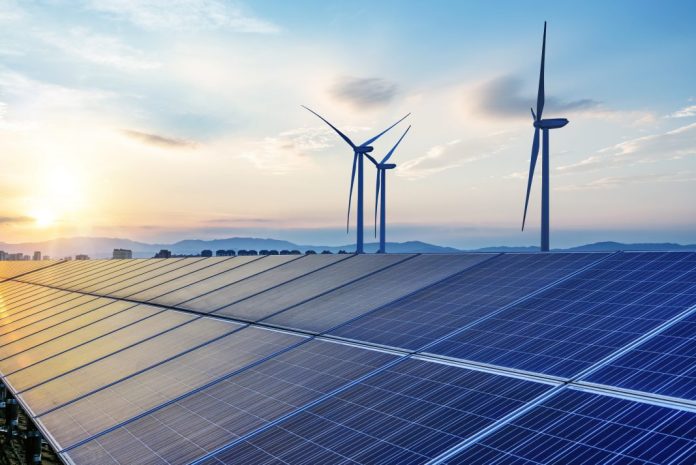As war rages in Ukraine and the ensuing energy crisis stoked by Russia’s aggression takes hold, the need for energy independence, such as solar energy, has never been more apparent
In the 12 months following tanks crossing the Ukrainian border, the price of EU Natural Gas went from €80 MWh to €340 MWh. The soaring price of gas in Europe, and by extension electricity, has been shot in the arm of European renewable energy investment. Despite its low historical gas imports from Russia, the UK is no exception to this trend.
Although the UK’s electricity grid is already one of the cleanest in Europe, with renewable energy making up 42% of the national grid’s power source, the need to diversify further into the sector persists. With mounting pressures from government, consumers, and shareholders, it is estimated that switching to clean energy in Europe by 2050 will require $5.3 trillion of investment. Britain has already achieved a leadership position in offshore wind. By 2019 Britain’s ~2,600 offshore turbines accounted for 45% of all European offshore wind and a staggering 33% of global offshore capacity. Now it’s solar power’s time in the sun.
Investments in solar panels and other renewables
The investment case for solar continues to improve, even for a nation famed for its bad weather. According to the International Renewable Energy Agency (IRENA) 2021 World Energy Outlook, renewables like solar and wind power are now the cheapest form of electricity generation. The vast investment and advances in solar panel manufacturing have seen prices fall by 82% between 2010 and 2020. Falling hardware prices and improvements in panel efficiencies have significantly bolstered yields and the overall economics of solar. This is most apparent in residential rooftop solar, where a 4KW system with a battery can cover an average UK household’s electricity needs and pay itself off in 7 years.
Whilst predicting the precise economic returns for a single solar panel is closer to an art than a science,?solar panels have more to offer than just cost benefits. Adopting rooftop solar systems to improve EPC ratings on UK buildings by leading UK housing associations – such as North Lincolnshire Homes, Fold Housing Association and Wales & West Housing – demonstrates the environmental benefits and social benefits of solar. Other tailwinds buoying solar include improvements in metering and billing services that pave the way for multiple-occupancy buildings to benefit from the solar infrastructure. This is evidenced, for example, by Allume Energy’s recent solar installations on Wales & West Housing units in Cardiff. However, it is not all plain sailing yet: supply shortages backlogged by COVID-19 and lengthy installation delays may prevent homeowners from soaking up the sun’s rays for many months.
Increasing scrutiny on suppliers of solar panels
Indeed, increased scrutiny by suppliers of European panels as to where the components (solar modules) and raw materials (polysilicon) are sourced from is itself jamming up supply chains. China, which produces 70% of silicon and 83% of solar modules, has played a huge role in drastically reducing the cost of solar panels. This, in part, results from significant government subsidies and cheap electricity costs offered to polysilicon manufacturers. However, a more sinister factor lies behind this miraculous supply of solar materials.
SIGNIFICANT PROPORTIONS OF CHINESE SOLAR MATERIALS EMANATING FROM XINJIANG WERE MADE USING FORCED LABOUR AND FORCED INTERNMENT OF THE UIGHUR MUSLIM MINORITY
In May 2021, research conducted by Sheffield Hallam University revealed that significant proportions of Chinese solar materials emanating from Xinjiang were made using forced labour and forced internment of the Uighur Muslim minority. Based on this research, Zamo Capital estimated that ~8% of global polysilicon supply and 5-10% of global solar module supplies were made with direct forced labour. The real challenge lies in the tracing of materials through multiple tiers of the supply chain. “Dirty” materials can be blended with “clean” materials, effectively greenwashing the final product by obscuring the provenance of its base materials.
Examining forced labour in solar energy supply chains
At Zamo Capital, we have observed two primary trends resulting from the discovery of forced labour in solar supply chains.
Reduce dependence on the Chinese supply of solar materials
The first has been a drive to reduce our dependence on the Chinese supply of solar materials by securing clean and transparent supply through onshoring, much like the impetus from the Ukrainian conflict to achieve energy independence from Russia. This has been inculcated in the USA by Biden’s colossal renewable investment policy: the Inflation Reduction Act, which will direct $430 billion of federal funding to support the transition to clean energy. Europe has also supported this through the Green Deal Industrial Plan presented to the European Commission in early February 2023.
A push to clean up our supply chains
The second trend is a concerted push to clean up our supply chains through improved diligence, transparency, and penalties for bad actors. Joe Biden’s Uyghur Forced Labour Prevention Act, passed in December 2021, stands as a landmark case to incentivize transparency in supply chains. Europe has fallen behind the US on the efficacy and extent of its legislative agenda. In February 2022, the European Commission issued a directive on Corporate Sustainability Due Diligence in response to the Uighur Forced Labour Prevention Act. The directive is far more moderate and will take effect in two years and apply only to larger-size companies.






